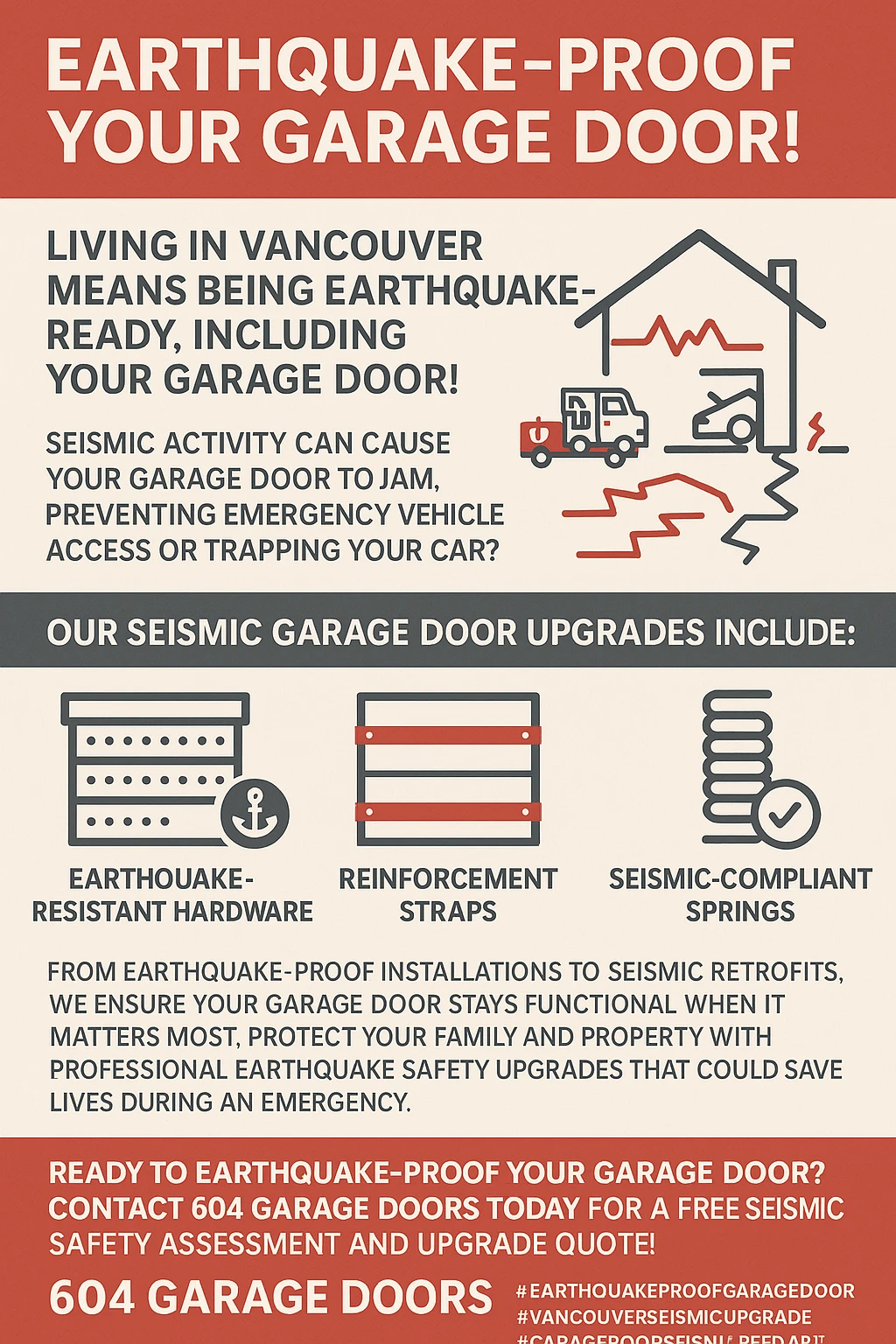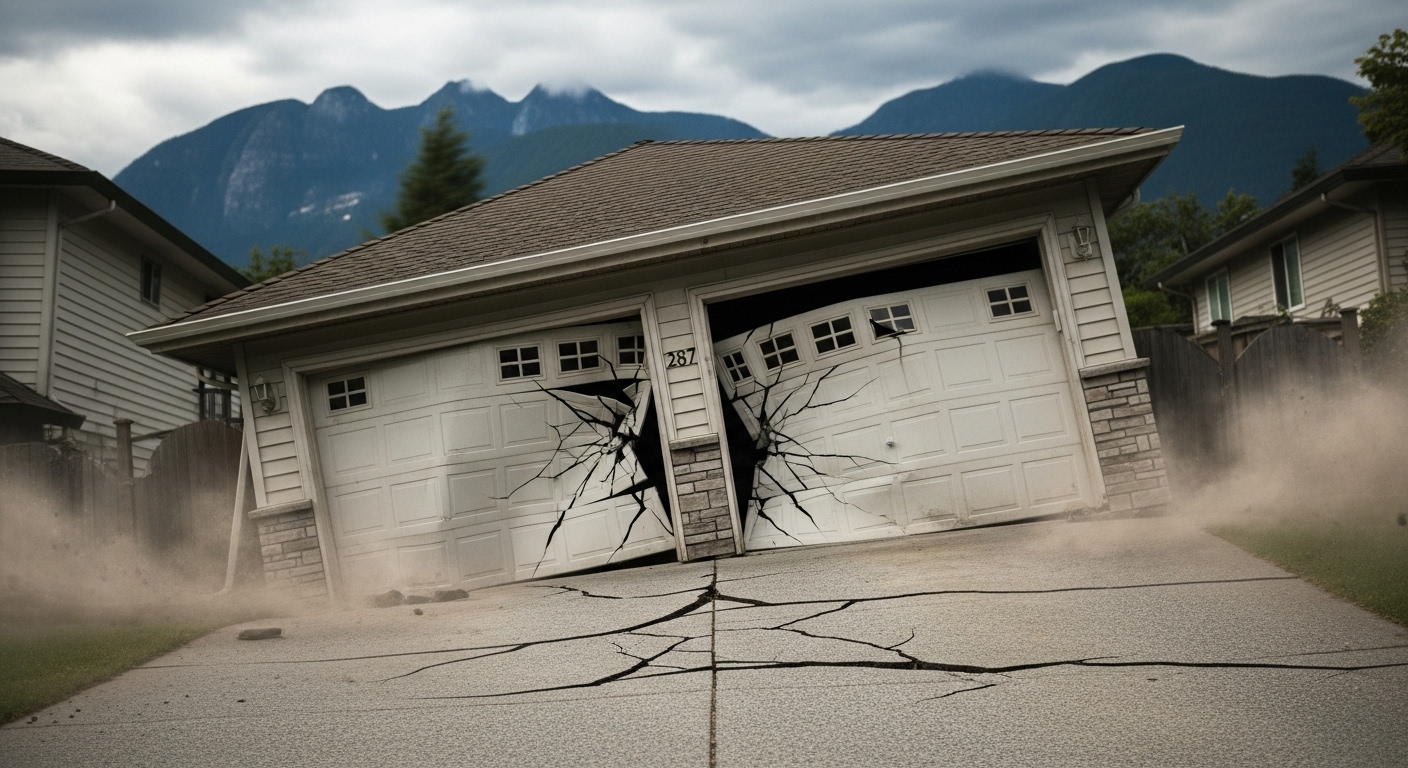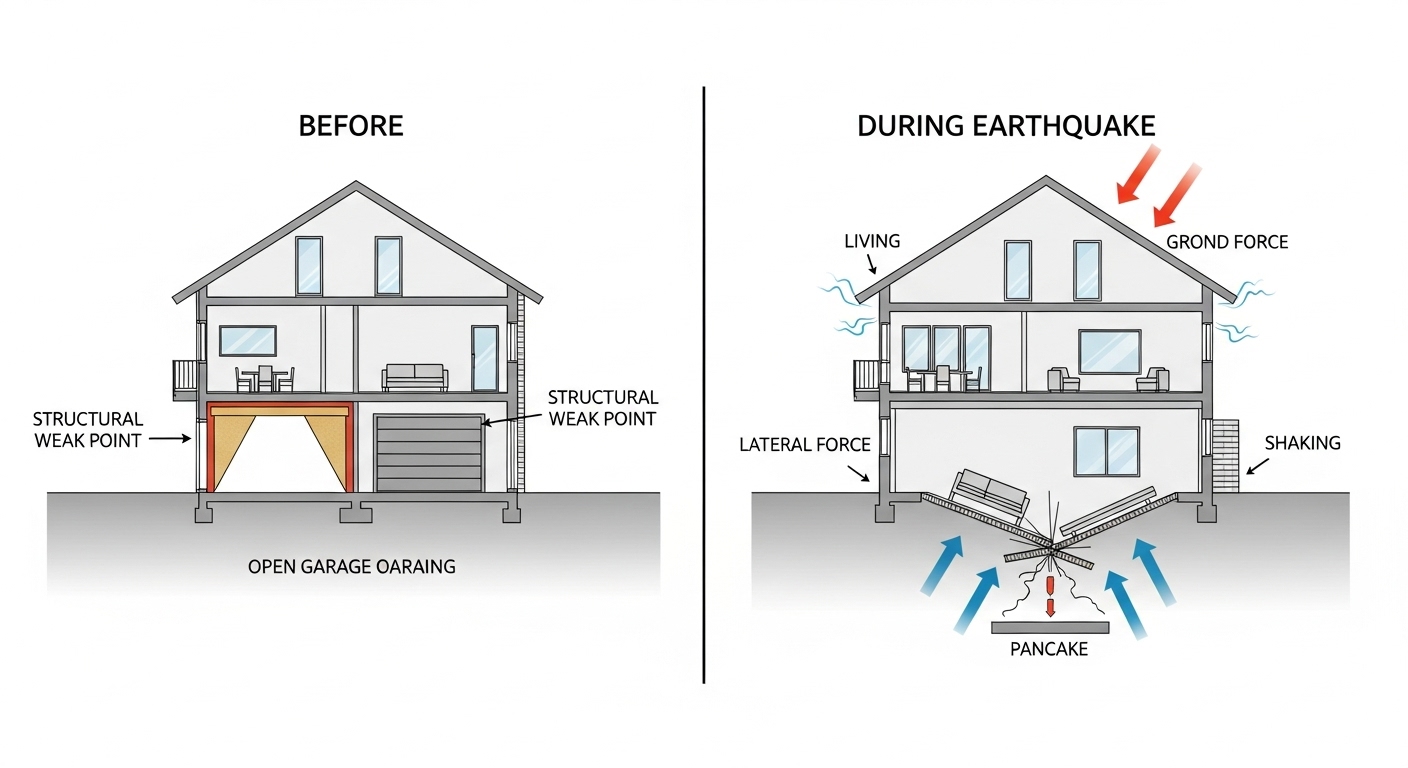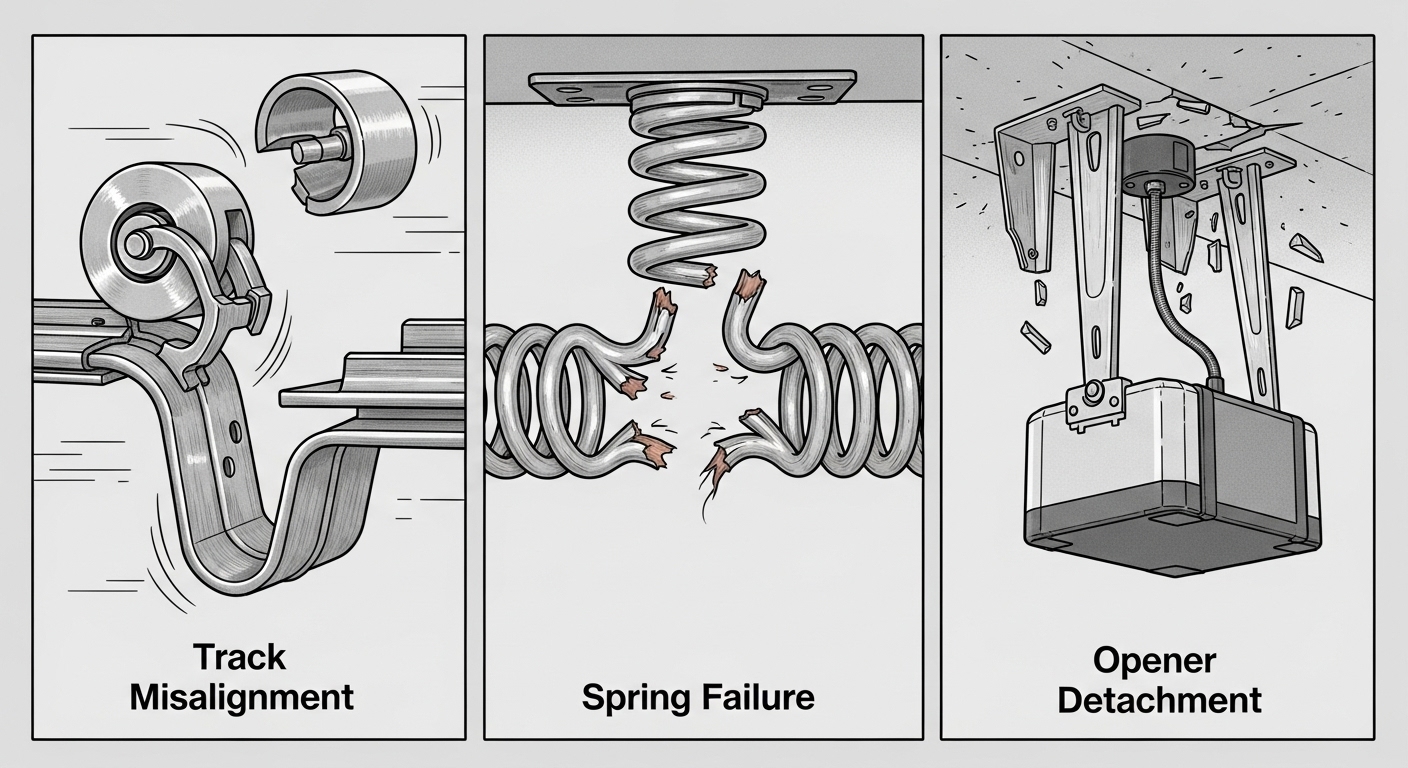Worried about how Vancouver’s earthquake risk could affect your garage door? The Cascadia Subduction Zone poses a real threat to Metro Vancouver, and your garage door could be a critical failure point during seismic events without proper reinforcements and safety upgrades.
Picture this: you’re rushing to evacuate during an emergency when a massive earthquake hits Vancouver, but your garage door is completely stuck because the tracks got misaligned from foundation shifting. Or maybe you’ve made it through the initial shaking safely, but now you’re trapped in your home because your garage door opener detached from the ceiling and the door panels cracked under seismic stress. These aren’t far-fetched scenarios – they’re exactly what happened to thousands of homeowners during major earthquakes in California, and Vancouver sits right in the path of the powerful Cascadia Subduction Zone.
Your garage door represents one of the largest moving structures in your home, and it’s often the weakest link in your home’s earthquake preparedness. Most Vancouver homeowners focus on securing furniture and creating emergency kits, but they completely overlook the massive opening in their home’s structure that could become a catastrophic failure point when the ground starts shaking. The good news? With the right safety upgrades, reinforcement solutions, and maintenance protocols, you can transform your garage door from a seismic vulnerability into a reliable emergency exit that could literally save your family’s life.
From understanding how Vancouver’s unique soil conditions amplify earthquake damage to installing battery backup systems that keep your door operational during power outages, this guide covers every aspect of earthquake-proofing your garage door. You’ll learn about steel frame reinforcements that prevent structural collapse, discover building code requirements specific to BC’s seismic zones, and find out which upgrades provide the best return on investment for protecting your property and family.
Key Outtakes:
- Vancouver’s location near the Cascadia Subduction Zone makes seismic garage door upgrades essential for home safety and property protection, especially in homes built before modern building codes.
- Garage doors fail during earthquakes through foundation shifting, track misalignment, component breakage, and opener detachment – problems that can trap you inside or lock you out when you need emergency access most.
- Steel frames, plywood panels, earthquake-resistant hardware, and proper anchoring are proven methods to reinforce garage door openings and prevent catastrophic collapse during seismic events.
- BC Building Code requires specific seismic bracing for garage door openings, particularly in soft-story homes where living spaces sit above garages, creating structural vulnerabilities that can cause total building collapse.
- Battery backup systems, smart monitoring technology, and regular professional maintenance ensure your earthquake-reinforced garage door remains functional during emergencies and provides reliable evacuation access when power grids fail.

Understanding Vancouver’s Earthquake Risk and Garage Door Vulnerabilities
Vancouver hasn’t experienced a major earthquake in recent memory, which creates a dangerous sense of complacency among homeowners who don’t realize they’re living directly in the path of one of North America’s most significant seismic threats. The Cascadia Subduction Zone stretches from Vancouver Island down to Northern California, and it’s capable of producing magnitude 9.0+ earthquakes that would dwarf anything most residents have ever experienced. Recent research suggests the Cascadia and San Andreas faults may even be seismically synchronized, raising the possibility of simultaneous earthquake events spanning from BC all the way to California.
What makes this particularly dangerous for garage doors is that Vancouver’s soil conditions can dramatically amplify earthquake forces in ways that most homeowners never consider. Areas built on deep loose sand, silty clays, and water-saturated soils – which describe much of Richmond, parts of Surrey, and other Fraser River delta communities – experience what engineers call a “quicksand effect” during seismic events. The ground literally becomes incapable of supporting foundations, causing them to crack, heave, and settle unevenly. When your foundation shifts even slightly, your garage door tracks become misaligned, panels can crack from structural stress, and the entire door system may become completely inoperable.
This isn’t theoretical concern – it’s exactly what happened during the 1994 Northridge earthquake in California, where thousands of garage doors became stuck because foundation movement caused track misalignment and structural damage. The Canadian government’s earthquake preparedness guidelines specifically mention that Vancouver area homes built before modern seismic codes are particularly vulnerable, and garage door openings represent some of the largest structural weak points in these buildings.
Vancouver’s building codes have evolved significantly over the past two decades as scientists have learned more about the Cascadia Subduction Zone threat. Homes built before 2000 – and especially those constructed before 1990 – typically lack the seismic reinforcements that engineer now know are essential for earthquake survival. Your garage door opening may be secured with nothing more than basic wood framing and standard hardware that was never designed to withstand the lateral forces generated by major seismic events.
The risk becomes even more serious if you live in what structural engineers call a “soft-story” configuration, where you have living space built above your garage. These homes are particularly vulnerable because the large garage door opening creates a structural weak spot that lacks interior walls to resist side-to-side shearing motion during earthquakes. Without proper reinforcement, the columns supporting the living space above simply can’t withstand earthquake forces, leading to catastrophic collapse that brings down the entire upper floor.

How Earthquakes Damage Garage Doors: Common Failure Points
Understanding exactly how earthquakes damage garage doors helps you prioritize the most effective safety upgrades and reinforcement solutions. The failure patterns are remarkably consistent across different seismic events, which means Vancouver homeowners can learn from earthquake damage studies in California and prepare accordingly. Most garage door failures during earthquakes follow predictable patterns that start with foundation movement and cascade through the entire door system.

Foundation and track misalignment represents the most common and immediate garage door failure during seismic events. When earthquake shaking causes your home’s foundation to shift – even by just a few inches – your garage door tracks no longer align properly with the door panels. The door may become stuck partway open, operate at dangerous angles, or completely derail from its guide system. This misalignment often persists even after the earthquake stops, leaving you with a garage door that’s permanently inoperable until professional repairs are completed.
Component failures under seismic stress create additional safety hazards that can persist for hours or days after the initial earthquake. Garage door springs and cables operate under tremendous constant tension – often 400+ pounds of force – and this tension combined with violent earthquake shaking can cause springs to snap or cables to break. When these critical components fail, your garage door can slam shut unexpectedly, fall from its tracks, or become impossible to open manually. The failure of just one component can render your entire garage door system unsafe and inoperable.
Garage door openers face unique challenges during earthquakes because they’re typically mounted to ceiling joists that experience significant movement during seismic events. Poorly secured openers can detach completely from the ceiling, creating falling debris hazards and leaving you with no way to operate your door electronically. Even if the opener stays attached, the sensitive electronic components inside can become damaged or disconnected from excessive vibration, leaving you dependent on manual operation that may be difficult or impossible if other components are damaged.
The soft-story building vulnerability deserves special attention because it represents an existential threat that goes far beyond garage door functionality. When you have living spaces built above your garage, the large door opening creates what engineers call a “soft story” – a floor level that’s structurally weak due to lack of interior walls that provide resistance to lateral earthquake forces. California earthquake experts estimate that soft-story buildings can experience complete collapse during major earthquakes, with the garage level pancaking and bringing down all floors above it. This isn’t just garage door damage – it’s a life-threatening structural failure that requires comprehensive retrofitting to prevent.
Essential Seismic Garage Door Upgrades for Vancouver Homeowners
Now that you understand the specific ways earthquakes damage garage doors, you can focus your safety investments on the most effective reinforcement solutions that provide maximum protection for your family and property. The key is implementing a layered approach that addresses structural vulnerabilities, component weaknesses, and emergency backup systems to ensure your garage door remains functional when you need it most. Professional earthquake retrofitting combines proven structural engineering principles with practical emergency preparedness features.



